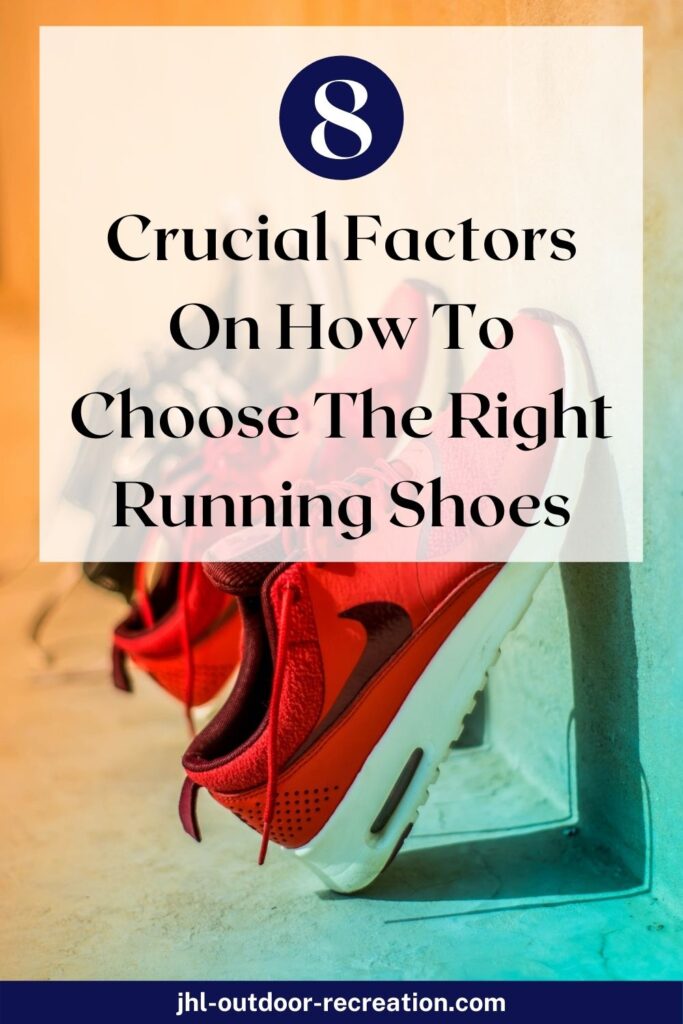I was (am still) a couch potato. One day, though, I decided to start running. So, I needed a pair of running shoes. But, if you asked me if I knew how to choose the right pair of running shoes, I would simply say “No idea!”
Well, I didn’t really care. I went to a sportswear shop and saw varieties of running shoes. But, I was not aware of the function and design of the running shoes.
FYI, I hated the shop assistant. I purposely avoided him so he couldn’t ask me if anything that he could help with. That was because I really had no idea at all!
Well, I simply grabbed a pair of running shoes, tried them and pretended that I had found the right ones. After the purchase, I left the shop with the speed of light!
That’s how I chose running shoes back then. Yeah, we can simply choose any pairs of running shoes, right?
But, IGNORANCE is costly! It turns out the running shoes might cause discomfort and feet-related injuries.
And that’s why ERGONOMICS kicks in when we choose right running shoes. It makes running comfortable and minimizes the chance of injuries.
So, I’ll share with you the 8 crucial factors that you should take note on how to choose the right pair of running shoes!
1. Expectations
Ok, before we go to the technical part, let’s take a step back and have some internal thoughts first.
Ultimately, your running shoes should meet your running EXPECTATIONS.
There are several factors that you must consider at this point:
1.1 Purpose
Either you want to run on trails or roads / treadmill. Simple reasons. Trails are undulating and uncertain (both soft and rocky). Roads / treadmills, however, are hard and straightforward.
So, here’s the combination:
- Trail running – trail running shoes (trail runners)
- Road / treadmill running – daily trainers / sneakers
I saw a few runners wearing daily trainers while trail running. You know what? I cringed. They could hurt their butt! And injuries, of course!
Running shoes are designed for specific running occasions. We don’t want unnecessary discomfort and injuries while running.
So, take it seriously and don’t mix them up.
1.2 Experience level
Are you a beginner or an experienced runner?
If you are a BEGINNER, I presume your running skills aren’t mature yet. So, you might consider running shoes with thick cushion to absorb the shock.
If you are an EXPERIENCED runner, I believe your running skills are on top-notch. You already know how to reduce impact while running. So, you might consider lightweight running shoes.
1.3 Pace & comfort
Guess what? Pace and comfort are crucial when you want to choose the right pair of running shoes. And yet, they “conflict” with each other!
Usually, a pair of running shoes with great comfort are not great for fast pace. Likewise, a pair of running shoes that are designed for fast pace will upset the comfort.
Hence, be clear with your running perception, either jogging or running fast / training like marathoners.
Further discussions are in the section “stack height & cushion” below.
2. Biological factor
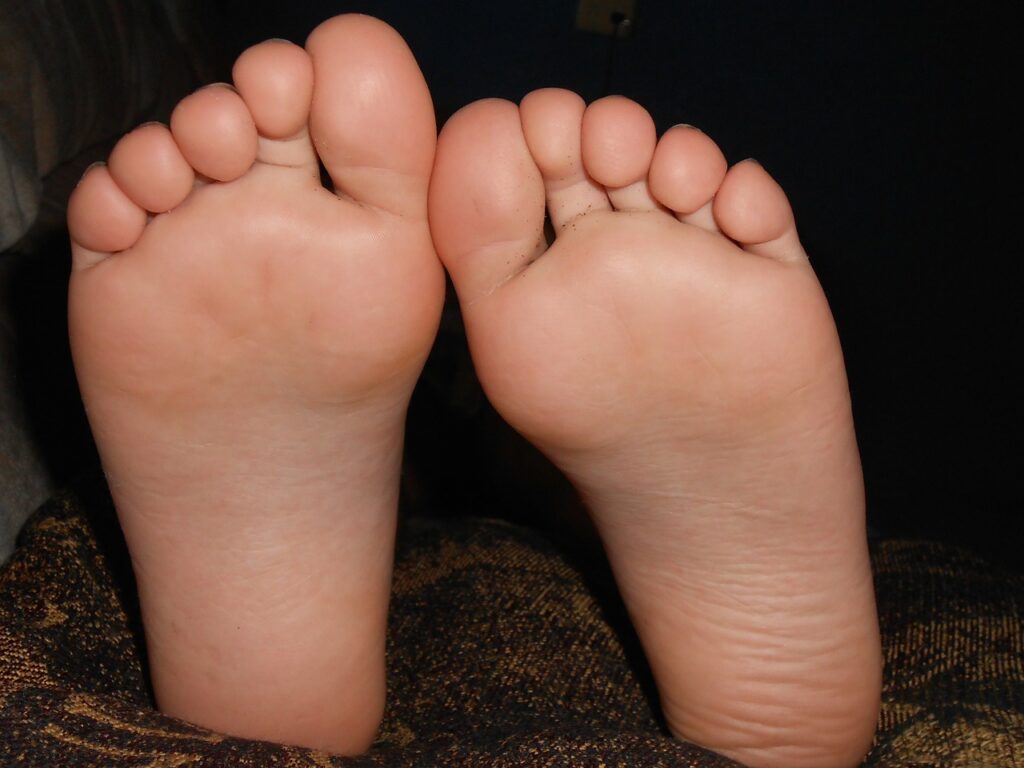
A good pair of running shoes should fit our running style and feet type. Not the other way round. – Unless we want to alter our running form and technique.
That’s why a good pair of running shoes should be ERGONOMIC. After all, we want to run comfortably at the expected pace to avoid unnecessary injuries.
There are 3 biological factors to consider before you choose the right pair of running shoes.
2.1 Pronation
This simply means how our feet roll inwards to absorb impact when landing. However, the degree of inward rolling differs from person to person.
The inward rolling degree determines how our legs absorb the impact. So, proper running shoes should support the pronation.
And there are 3 types of pronation. As a runner, you need to know what type of pronation you have.
- Supination – There is minimal (or none) inward rolling. Meaning, your outer heels contact the ground and your push off with outer ball of feet. This is typical for High-Arch feet.
- Neutral – Your outer heels contact the ground, and slightly roll inwards to absorb the shock. Then, you push off with the entire ball of feet (well-balanced impact absorption). This is typical for Neutral-Arch feet.
- Overpronation – Your feet roll inwards excessively and collapse. Then, you push off with the inner ball of feet. And this usually causes Flat feet.
2.2 Weight
You’ve heard of this: our feet absorbs X times of our body weight when running. – 3 times, 4 times, 5 times, or whatever……
Imagine while we run non-stop, our feet absorb huge amount of impact, and our body weight dictates the quantum of the impact.
So, the heavier we are, the more impact that our feet absorb. And that can cause discomfort and injuries!
Translation. The heavier we are, the more support that our feet need. And hence more amount of CUSHION of running shoes is needed.
So, how much is considered as “HEAVY”?
Well, this article, based on a study, states that runners weighing over 85kg with lightweight running shoes are over 3 times more likely to sustain an injury than wearing conventional running shoes.
It seems like 85kg is the threshold. If you weigh 70kg, for instance, you can choose lightweight shoes.
Or, if you weigh 90kg, lightweight shoes might not be a good choice. You may need running shoes with more cushioning.
2.3 Foot strike
Experienced runners should already know this. But, for the sake of beginners, these are the typical 3 types of foot strikes:
- Heel strike – Land on heel. Majority will fall under this category. But, heel strikers might have the risk of knee injuries.
- Midfoot strike – Land on midfoot. Midfoot strikers might suffer ankle injuries.
- Forefoot strike – Land on forefoot. Similar to midfoot striking, forefoot strikers might also suffer ankle injuries.
It’s like a puzzle when you choose the right running shoes. Once you have identified the above, you already solve more than half of the puzzle.
Now, let’s look at the technical parts which relate to both daily trainers and trail runners.
3. Types of running shoes
The degree of pronation dictates the type of running shoes that you need. Not only that, this helps reduce or prevent possible injuries.
And here are the most common categories of running shoes.
3.1 Cushioned shoes
These are made with cushioning but with least support. Usually, they have shock dispersion in the outsole and midsole.
These shoes ENCOURAGES feet inward rolling to absorb impact. Hence, they are mostly suitable for runners with SUPINATION.
Hence, indirectly, this shoes help prevent the following common injuries of supinated feet:
- Shin splints (eg shin pain)
- Plantar fasciitis (foot pain caused by the band of tissue that connects the heels and the ball of feet)
- Ankle strain
3.2 Motion control shoes
As the name suggests, these shoes CONTROL the inward rolling motion to minimize collapse. They have wide sole to restrict the excessive motion and collapse.
Because of this, the shoes are usually rigid. And these shoes are suitable for runners with OVERPRONATION.
So, this also indirectly helps prevent the common injuries from overpronation:
- Shin splints
- Plantar fasciitis
- Achilles tendinitis
- Heel spurs (calcification due to constant pull on the heel bone to cause abnormal growth)
3.3 Stability shoes
This is simply the middle-range of cushion shoes and motion control shoes.
Usually, they have good blend of cushioning and support. They don’t strictly control the motion of foot like motion control shoes.
Hence, they are perfect choice for NEUTRAL feet runners.
4. Stack height & cushion
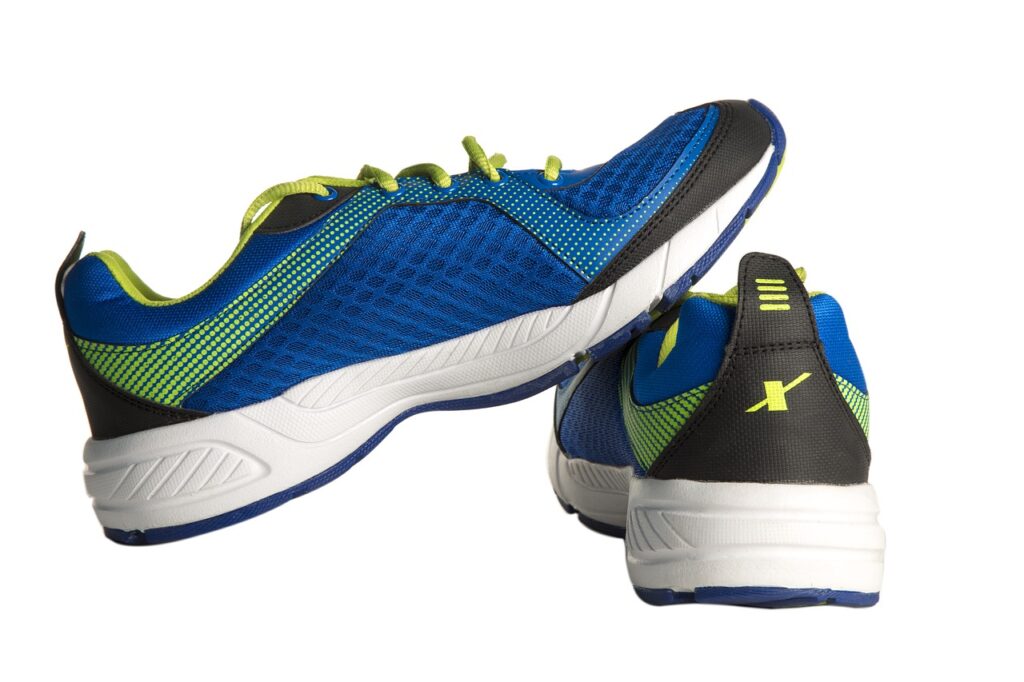
Let’s say your height is 168cm on barefoot. After you wear a pair of running shoes, you height becomes, say, 171cm. – Wow, you gain 3cm!
Simply said, that’s stack height. That’s the height that represents the thickness of the material of the shoes between your feet and the ground.
The reason is simple. That’s cushioning. It helps make running comfortable and absorb impact. – So, it helps reduce injuries.
For this purpose, there are a few spectrums, from Barefoot / Minimal (thin) to High / Maximal (thick).
There are 2 factors when considering the proper stack height.
- Weight – The heavier you are, the more support you need. Hence, you need high / maximal stack height.
- Comfort vs pace – If you want to jog peacefully, then you can consider high / maximal stack height running shoes. Or, if you aim for speed running, you can consider minimal stack height shoes (lightweight shoes). That’s because they are much lighter.
5. Heel-to-toe drop / offset
Don’t confuse this with stack height.
For running shoes, heel-to-toe drop (offset) represents the height differences between the heel and the forefoot.
The range of the offset is between 0mm to 14mm.
The higher the heel is, the larger the offset is. Consequently, this encourages forward leaning running posture.
Forward leaning is crucial for running. This helps switch the centre of gravity of runners, and thus minimize over-striding and risk of injuries. – Meaning, forward leaning improves running efficiency.
And that’s why you need to know your foot strike!
Well, usually forefoot / midfoot strikers already lean forward while running. So, they don’t really need offset to further promote forward leaning. – Thus, there you go with low or zero offset.
Conversely, heel strikers need high offset running shoes so that they can learn forward while running.
6. Shoe size
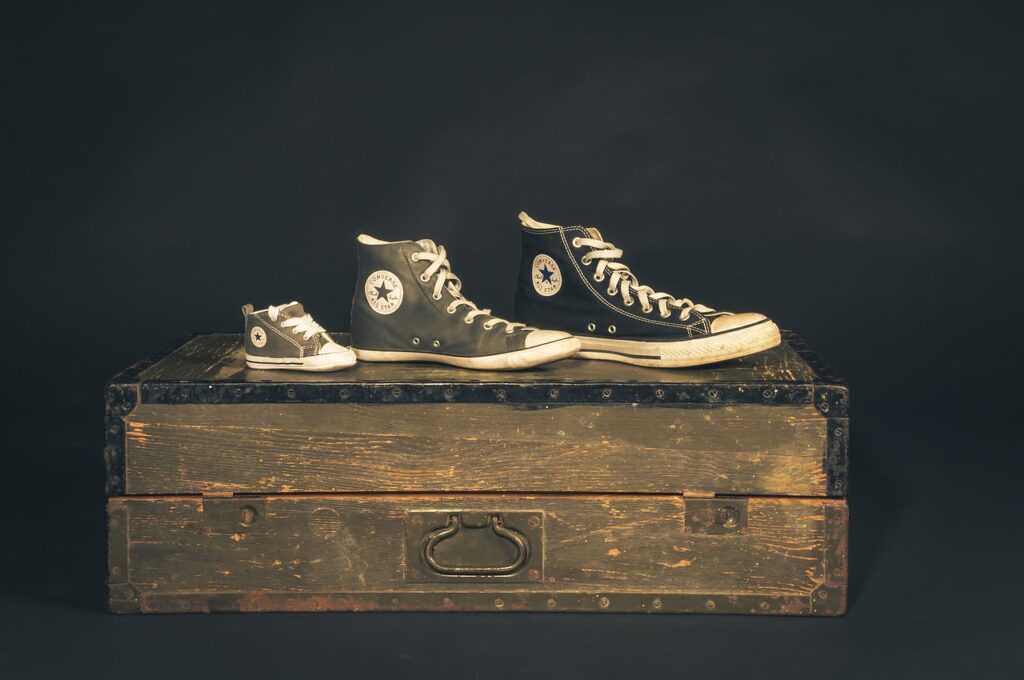
Do you know that running shoes size should always be slightly bigger than your actual shoe size? – Cool, huh?
Think about this. Regardless of trail or road / treadmill running, your toes constantly “push” forward and hit the tip of the shoes.
This causes friction which results in toes injuries, such as black toenails, or even toenails fall-off.
Hence, you need a little space between your toes and the tip. And usually is the width of your index finger.
Or you can just simply press the tip of the shoes to ensure there is space between your toes and tip.
And there are a few things to consider when you choose the right size of running shoes.
6.1 Brand
Different brands have their own cutting. For example, a 7 feet size of Adidas might be slightly bigger than a 7 feet size of Nike.
Thus, you need to TEST before you buy. – Unless you buy online.
6.2 Test with socks
It’s preferable to test for ACTUAL running. So, try to test while wearing socks.
Firstly, thickness of socks affects the actual fit of running shoes. Secondly, testing with socks gives u a better feel while running. – This helps you grab the actual feel of wearing the new running shoes.
6.3 Timing of testing
Do you know that our feet are bigger in the evening / at night?
Weather temperature and humidity can influence our body temperature. And this affects our blood circulation, causing our feet to shrink or expand.
What does this tell us?
Simply said, we should test the running shoes at the same timing as our running session. For example, if you are a morning runner, rightfully you should test the shoes in the morning.
Well, if you don’t have exact timing for running, you should always test the shoes in the evening. – You don’t want to buy running shoes which are too tight, right?
7. Price
Price shouldn’t be a major factor as the prices are about the same. Typical running shoes cost between $50 and $100.
But, some fancy running shoes do cost much more than that.
So, choose the average or fancy ones? – Well, it’s really subjective.
Typically, you need to know if the following justify the premium:
- Brand
- Design
- Breathability & technology
- Expected usage
Some running shoes are claimed to have better breathability and technology. For example, they could help cool down the feet and reduce sweat.
Or, some running shoes have ultra-long expected mileage, say, 2,000 miles (while the average are 400 miles).
Or, the design looks really cool or trendy……
After all, whether these justify the premium or not, only you know the answer.
8. Analyses
You know what? The biological factors above seem technical and complicated. In the end, we still don’t know our pronation type or foot strike.
Don’t worry. We have simple ways to find out. And these are:
8.1 Wet test
Check our footprint. This is easy to do. You just need a container and a dry paper / card (of course, your lovely bare feet).
Step 1 – Fill the container with water and place the dry paper / card next to the container.
Step 2 – Rinse your feet in the water.
Step 3 – Remove your feet from the container and shake slightly to remove excess water.
Step 4 – Place your feet on the dry paper / card and stand up straight for 4 to 5 seconds.
Step 5 – Check your wet footprint. And see which type of pronation you have.
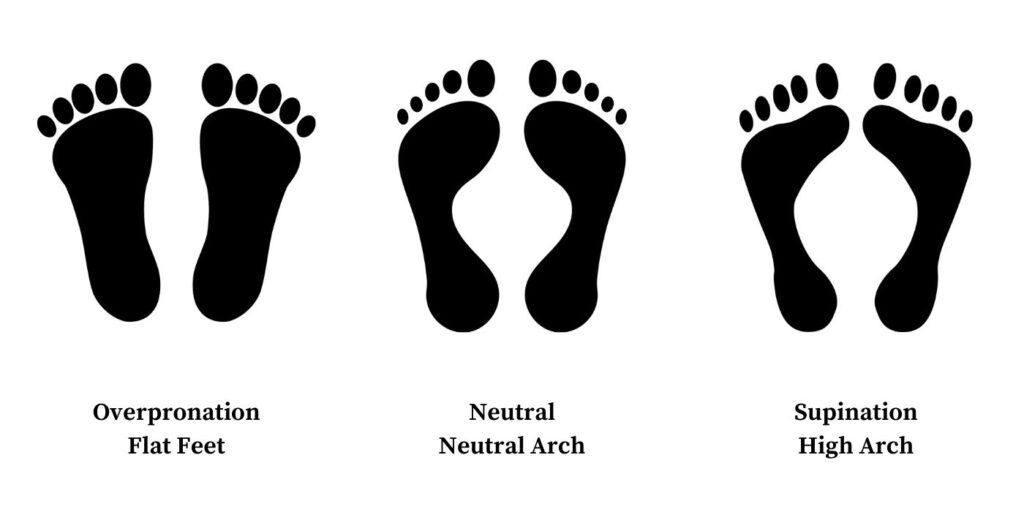
8.2 Gait analysis
Some sportswear shops provide gait analysis for runners before their purchase. If they provide this analysis, you should do this!
In fact, it is also a simple analysis like wet test. You just need to run as usual on a treadmill. Then, the experts will record and analyze your gait. – Both pronation and foot strike.
From there, they might give you some advice on the right running shoes for you.
You could discuss your expectations with them, too.
Final thought: choose the right running shoes
Many people, including me, buy running shoes without knowing the technical parts. We end up buying the running shoes that don’t match with our running style.
But, we shouldn’t ignore the technical parts because they are critical when we choose the right running shoes.
Although it seems tough to start with, essentially we just need to know our expectations and the biological factors.
The rest are just filling up the puzzle. Spend some time to do some research and complete the puzzle!
Relevant posts
